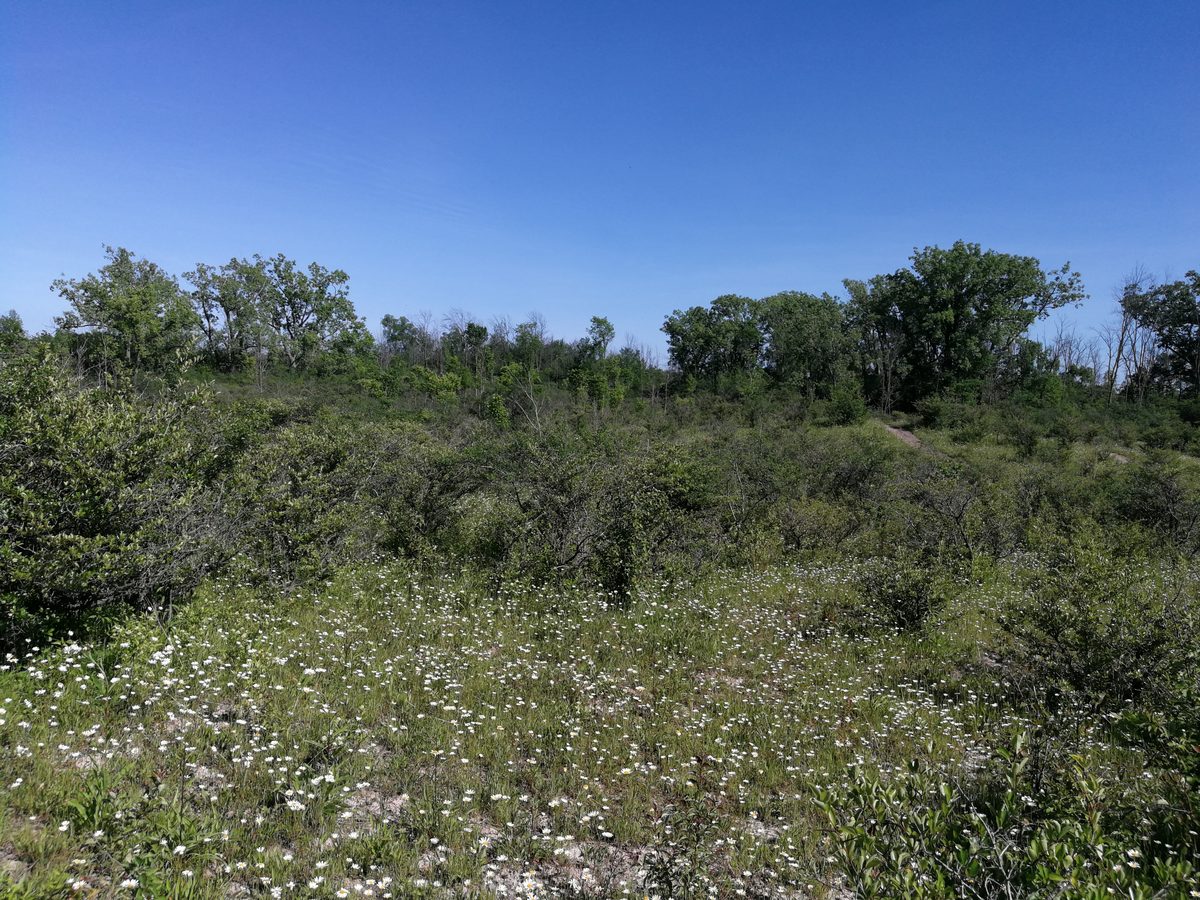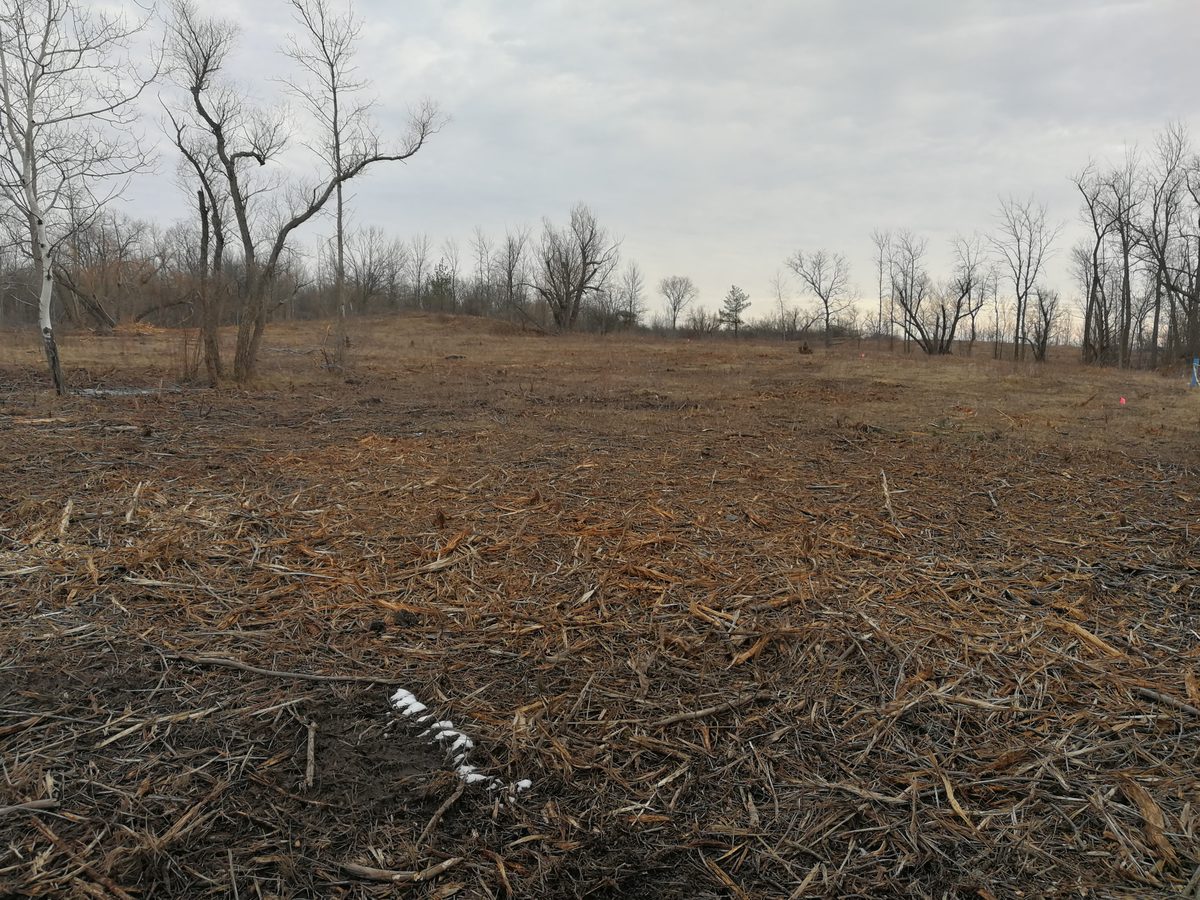This article is detailed follow up to Developer Charged With Illegal Cut in Thundering Waters (follow link to previous article)
From my personal observations, it appears the cut area at Riverfront Residential involves approximately 50 acres. It involves all the areas proposed for residential development in the open “cultural thicket” lands between the western edge of the proposed development and the forested wetland to the east. There is yellow tape on the site that appears to delineate the western edge of the clearance and some of the protected wetlands.

Photos provided to Dr John Bacher anonymously. Top photo was taken July 2019 before illegal mowing. Bottom photo was taken of mowed area February 2020.
Some specific observations:
1. General Area and Some Significant Species Described in Dougan EIS of Larger Thundering Waters Development Proposal in 2016.
The Dougan Report describes the cut area as Polygon 16, a mineral cultural thicket. It is described as being dominated by dotted hawthorn, “with the occasional gray dogwood, and scattered trees”, such as gray dogwood, American elm and eastern cottonwood. Surprisingly, considering later studies by GR Canada’s subsequent consultant, Savanta, there is no mention of the exotic invasive species of buckthorn (common and purging buckthorn).
The Dougan Report found two regionally rare plant species within the dotted hawthorn-dominated thicket area: Canada pussytoes and yellow sedge.
According to the mitigation plans for the Riverfront Residential proposal there would be collection and recovery plans for various significant plant species. According to comments made by a representative of Savanta, at the January 30, 2020 public meeting, these mitigation actions did not take place. No Savanta employee was present when the cut took place, or afterwards. The representative said this is also true for the earlier tree cutting violation which was supposed to be for a road to allow for the passage of bore hole testing equipment.
2. Mowing Took Place Where Regionally Rare Butterfly Milkweed (Asclepias tuberosa) Present
Butterfly milkweed, a regionally rare species was not originally identified in the Dougan Report. It was later discovered by myself (John Bacher) with assistance from Adrin Willems. Subsequently, the species was confirmed by Savanta in its Environmental Impact Study (EIS). The original EIS (September 2017, pg 17), noted, “Butterfly milkweed is considered to be regionally rare in Niagara Region. It is known to spread along disturbed rail line edges.” Mowing here could have resulted in the extirpation of this species from its only other known location in Niagara Falls, the original location being Niagara Gorge. Savanta had the records and could have protected the species from such extirpation had their representatives been present when the mowing/cut took place. The loss of the species is also of concern for another species at risk which benefits from it, the monarch butterfly.
3. Unsupervised Mowing Damaged Habitat of Great Plains Ladies’ Tresses
The provincially rare orchid the Great Plains’ ladies’ tresses only known habitat in Niagara is entirely found in the now mowed area. The limitation on the subject lands within the mowed area can be seen on Figure 4c. Rare Species, of the Riverfront Residential EIS Addendum. These plants were supposed to be removed to relocation areas identified in the mitigation plan. At the January 30th, 2020 public information meeting, a representative of Savanta confirmed although mowing took place in the habitat, they had not yet determined if the rare species had survived.
4. Mowing Impact Largely Destroyed Area of Significant Early Successional Bird Habitat- Wrongly Discounted by Two EIS studies using different criteria.
Page 105 of the September EIS by Savanta correctly states that the subject lands contain the three required species to be considered Early Successional Breeding Bird Habitat. These are the brown thrasher, black-billed cuckoo and field sparrow. All these species are experiencing significant population declines, which is which is why the province following guidelines developed by the Nature Conservancy of the United States, has developed this type of Significant Wildlife Habitat (SWH) protection. The three-day mowing damaged most of the 15.7 hectares of what should be considered Candidate SWH.
Considerable debate over Ecological Land Classification (ELC) has taken place over whether parts of the subject lands are Significant Woodland, or what is termed “Cultural Thicket.” From a land-use planning perspective it is essentially not relevant, which ELC classification is used. Both Significant Woodland and SWH prohibit site alteration unless it can be demonstrated that no loss of ecological function can be demonstrated.
Rather than deny the loss of ecological function, Savanta’s reports have wrongly denied the ELC categorizations that trigger the Woodland and SWH protections of these now damaged lands. In the EIS for Official Plan Amendment 128 (September 2017), what was denied was that Woodlands designated by the Niagara Regional Official Plan are still Woodlands.
In the EIS (page 32), Savanta denied the SWH significance based on a 2010, “Natural Heritage Inventory 2006-2009 - Volumes One and Two.” At the time Savanta inappropriately cited the study to indicate that this type of habitat was common in the Niagara Region. At the time of this citation the study had been withdrawn from the NPCA’s website. In reality the study warned that a variety of SWH successional habitats were under intense pressure from urban development and at risk of disappearing.
The current Savanta EIS for Riverfront Residential does not cite the NPCA 2010 report to deny SWH status. What it does cite - wrongly - is the province’s SWH guidelines for Early Successional Breeding Bird Habitat. It maintains that these guidelines remove from consideration areas that are not “abandoned fields or pasturelands” (page 15). What the guidelines stress is not this but that sites have “a history of longevity”, and that they are not Class 1 or 2 Agricultural Lands. What makes the subject lands especially valuable for these species is precisely this longevity, as it has been allowed to regenerate since disruption by Ontario Hydro in the 1920s.
5. New Studies Indicate That Damaged Lands Foraging Habitat for Endangered Bats
The Savanta Residential EIS Addendum (page 17), notes that there is present on the now heavily impacted “cultural thicket and meadows” “some foraging habitat.” Bats, like barn swallows, brown thrashers, field sparrows, and black-billed cuckoos; are insect foragers.
Summary of Ecological Damages of Unsupervised Mowing -
1. Harm to locally rare species intended for relocation:
Canada pussytoes, yellow sedge, butterfly milkweed
2. Damage of habitat to provincially rare orchid -- Great Plains ladies’ tresses
Habitat damage could have been avoided if developer’s own ecological consultant had been on-site. And, if there were orchids present they were no doubt damaged despite the relocation plan which is part of the permit application.
3. Majority of shrub/early successional bird habitat on subject lands damaged
Mowing damaged areas which should be considered SWH habitat for presence of nesting brown thrasher, black billed cuckoo and field sparrow. Value of site shown by presence of appropriate conditions since 1920s. This is far superior to recently abandoned agricultural areas.
4. Mowing damaged recently identified foraging habitat for endangered bats
Bat acoustic surveys recently identified bat foraging habitat for three species of Endangered bats on mowed lands. These species are the little brown myotis, eastern small-footed myotis and northern myotis.
